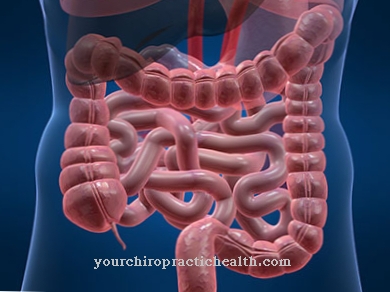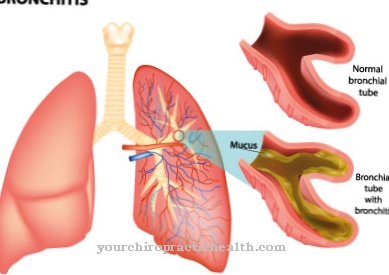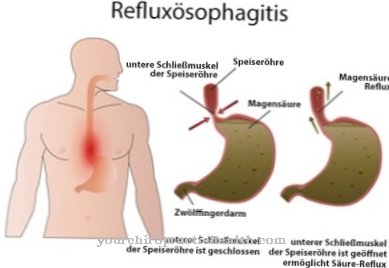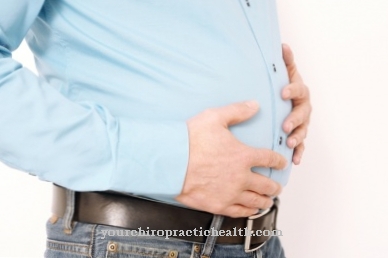The narrowing of a hollow body is called a stenosis. In case of a Intestinal stenosis it is the bowel, which can be narrowed for various reasons.
What is bowel stenosis?

© Sebastian Kaulitzki - stock.adobe.com
As a cavity, the intestine is the most important element of the human digestive system through which large amounts of meals consumed flow every day. Once a constriction has set in, for whatever reason, the body attempts to break through the constriction by increasing the natural movements of the bowel.
If the body does not succeed in this, there is a pathological case of intestinal stenosis, which requires immediate medical treatment. Because with intestinal stenosis, the continuously consumed meals build up, which in the worst case can lead to a complete blockage of the intestine and thus to the so-called megacolon: the inflation of the intestine to the point of rupture.
Another problem that arises is the risk of increased bacterial load: the meals remain at the narrowing due to the intestinal stenosis and are decomposed by the natural intestinal flora, which leads to an excessive multiplication of the germs living there.
causes
Intestinal stenosis can have different causes. It can be innate, for example, or it can only have set in over time. Intestinal stenosis plays a significant role, especially as a secondary disease of other major diseases. Examples are chronic intestinal inflammation, ulcerative colitis and Crohn's disease.
Here those affected suffer from chronic inflammation of the intestinal tract. The body tries to counteract the inflamed intestinal regions by increasing cell production. The inner wall of the intestine becomes thicker and thicker until an intestinal stenosis occurs.
You can find your medication here
➔ Medicines for constipation and intestinal problemsSymptoms, ailments & signs
Various symptoms and ailments can occur in the context of intestinal stenosis. Typically, gastrointestinal complaints such as abdominal pain, constipation, nausea and vomiting occur. These signs are often accompanied by intestinal colic, which manifests itself as cramp-like pain in the abdomen, and usually also causes sweats and circulatory problems.
In the worst case, bowel stenosis can lead to an intestinal obstruction. This manifests itself in stool retention and is life-threatening if left untreated. In extreme cases, it can lead to an intestinal tear and thereby cause peritonitis. Intestinal stenosis with intestinal obstruction is accompanied by an increasing feeling of illness.
Those affected are usually no longer able to get out of bed, which increases the impaired bowel movement. Intestinal stenosis also leads to a number of other, mostly unspecific complaints in the stomach and intestines. This includes, for example, stabbing or boring pain.
This is accompanied by a loss of appetite, which quickly leads to weight loss and deficiency symptoms. In addition, bad breath and a white coating form on the tongue. Externally, an intestinal stenosis can also be recognized by the pale skin and the typical tremors that occur with a pronounced intestinal disease.
diagnosis
The anamnesis is - as with all diseases - the first clue for the doctor to assume the presence of an intestinal stenosis. Typical symptoms are abdominal pain, i.e. abdominal pain that cannot be localized in any more detail and that occurs as a result of the narrowing. Furthermore, an abnormal stool is a typical clinical picture, which in extreme cases can even be bloody and slimy.
If there is an initial suspicion, the doctor has the patient X-rayed. Possible constrictions can be determined from the picture. The earlier a bowel stenosis is diagnosed, the lower the risk of possible complications, such as blockage of the bowel.
Complications
The intestinal stenosis causes considerable discomfort and complications in the stomach and intestines. In most cases it is then no longer possible for the patient to cope with a normal everyday life, as he constantly suffers from diarrhea or constipation. There is severe pain in the stomach region, which is associated with vomiting and nausea.
Flatulence can also make everyday life difficult. Due to the intestinal stenosis, the affected person often tends to reduce food intake. The constant diarrhea can also lead to severe dehydration and represent a very unhealthy condition for the body. It is not uncommon for this to result in a loss of appetite that can last for several days.
Bad breath develops and a white coating appears on the tongue, which suggests intestinal stenosis. In the worst case, an intestinal tear can occur. Treatment in hospital is usually necessary for intestinal stenosis. If this is done early, there will be no further complications.
If parts of the intestine have been irreversibly damaged, these are usually removed surgically. Furthermore, the person concerned must pay attention to a healthy diet in order to prevent the symptoms of intestinal stenosis.
When should you go to the doctor?
It is advisable to consult a doctor for the typical signs of intestinal stenosis such as vomiting and nausea, diarrhea, constipation and stomach pain. Patients with chronic intestinal inflammation such as ulcerative colitis are particularly prone to intestinal stenosis and should see a doctor immediately if these symptoms occur. The same is recommended for Crohn's disease patients, people with gallstones, chronic diarrheal diseases or intestinal tumors as well as pregnant women and people who regularly take certain medications such as antidepressants.
Anyone who belongs to one of these groups must seek medical advice immediately if they have symptoms of intestinal stenosis. In the case of intestinal stenosis, the chances of recovery are generally good, provided that the disease is recognized and treated early on. However, if the intestinal stenosis remains untreated, it can lead to an intestinal obstruction.
This manifests itself, among other things, by painful abdominal cramps, a bloated stomach and strong belching - warning signs that require emergency medical treatment. If a circulatory shock occurs, first aid measures must be provided immediately. In the event of such a severe course, a hospital stay is then required.
Doctors & therapists in your area
Treatment & Therapy
As already mentioned, an underlying disease is often responsible for the formation of intestinal stenosis. In this respect, this should first be treated so that the stenosis in the intestinal area usually regresses by itself.
For an initial relief, doctors use enemas that "liquefy" the stool that may have been blocked so that it can flow away more easily through the constriction and the pain is combated for the time being. Until the underlying disease has recovered, those affected should largely avoid foods that are difficult to digest. In severe cases, those affected are advised to use liquid food to prevent congestion in the intestinal stenosis.
If the narrowing has progressed so far that a blockage (Latin: ileus) has now formed, conventional treatment options are no longer possible. If there is a suspicion of an intestinal obstruction, the patient is admitted to the nearest specialized hospital, where the operation is carried out after further X-ray examinations.
The abdominal wall is opened and the closed part of the intestine is removed if it has died or there is reason to assume that the blockage will no longer loosen. In the case of removal, the patient is finally cured of the intestinal stenosis.
Outlook & forecast
In the case of intestinal stenosis, there is usually no self-healing. For this reason, those affected are in any case dependent on medical treatment to alleviate the symptoms.
In the worst case, the intestinal stenosis can lead to a complete intestinal obstruction, which can also lead to the death of the patient. Without treatment, those affected also suffer from severe abdominal pain and also from diarrhea or constipation. There is gas and nausea, often with vomiting.
Due to the severe pain, many patients do not consume any food or fluids, which can lead to dehydration or deficiency symptoms. The patient's quality of life is significantly reduced by the intestinal stenosis.
As a rule, the underlying disease of intestinal stenosis is always treated. This can alleviate the symptoms in the long term. In some cases surgical interventions are necessary, although there are no particular complications or other complaints. The disease can be completely cured, so that the life expectancy of the patient with intestinal stenosis usually remains unchanged.
You can find your medication here
➔ Medicines for constipation and intestinal problemsprevention
The extent to which bowel stenosis can be bowed cannot be said in general terms. Rather, what is decisive is the cause of the narrowing of the intestine. If this is hereditary, only regular preventive examinations can help against the closure; Recurrences, i.e. repeated occurrences after successful treatment, are conceivable in the case of congenital intestinal stenosis.
As a last resort, a colectomy comes into consideration, in which the large intestine is completely removed and instead a reservoir ("pouch") is surgically formed from the last part of the small intestine, which then takes over the task of the removed large intestine.
The colectomy is subject to the condition that only the large intestine is affected by the treatment-resistant intestinal stenosis. In other cases of intestinal narrowing, the treatment of an underlying disease is still one of the best options for preventing intestinal stenosis.
Aftercare
In most cases, the follow-up measures for intestinal stenosis depend very much on the time of diagnosis, so that generally no general prediction can be made. The earlier the illnesses are recognized and treated, the better the further course is usually, whereby self-healing cannot occur. Therefore, those affected should consult a doctor at the first symptoms and signs of the disease in order to avoid further complications and complaints.
In most cases, the treatment is carried out by taking antibiotics. Those affected should always pay attention to the correct dosage and regular intake in order to properly relieve the symptoms. If anything is unclear or if you have any questions, you should always consult a doctor first so that there are no further complications.
A balanced and healthy diet can also alleviate the symptoms of diseases. Patients often depend on the help and support of their own family and friends. This can also alleviate mental moods or depression. It cannot be universally predicted whether the diseases will lead to a reduced life expectancy for those affected.
You can do that yourself
People who have problems with their bowel movements can support themselves and their bodies in everyday life through a healthy lifestyle.
Avoiding fatty or very spicy food is helpful in order not to unnecessarily irritate or interrupt bowel movements. Any food that has been found to be difficult to digest in one's lifetime should be avoided. This must be checked individually and requires a good body awareness for your own needs. With a balanced diet rich in vitamins, the immune system is stabilized and bowel activity is stimulated.
Avoiding toxins such as alcohol, nicotine and unnecessary medication is also beneficial for digestion. There should be enough time between meals so that the bowel is not too full or overloaded. Purification or intestinal cleansing programs can also be used to strengthen general wellbeing and relieve the intestines. With sufficient exercise, the metabolic activity is additionally stimulated.
People who are particularly sensitive to stress should make sure that they do not expect too much. Your own emotional boundaries should not be exceeded in order not to let stressful situations escalate. A regular daily routine, observance of rest phases and good sleep hygiene are also helpful for intestinal activity.


.jpg)
.jpg)










.jpg)













